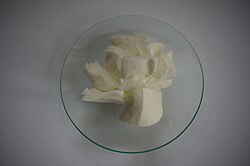
Back نيتروسيليلوز Arabic نیتروسلولز AZB Нітрацэлюлоза Byelorussian Нитроцелулоза Bulgarian Nitrocel·lulosa Catalan Nitrocelulóza Czech Nitrocellulose Danish Cellulosenitrat German Νιτροκυτταρίνη Greek Nitrato de celulosa Spanish
| |||

| |||
| Names | |||
|---|---|---|---|
| Other names
Cellulose nitrate; Flash paper; Flash cotton; Flash string; Gun cotton; Collodion; Pyroxylin
| |||
| Identifiers | |||
| ChemSpider |
| ||
| UNII | |||
| Properties | |||
| (C 6H 9(NO 2)O 5) n (mononitrocellulose) (C | |||
| Appearance | Yellowish white cotton-like filaments | ||
| Melting point | 160 to 170 °C (320 to 338 °F; 433 to 443 K) (ignites) | ||
| Hazards | |||
| NFPA 704 (fire diamond) | |||
| Flash point | 4.4 °C (39.9 °F; 277.5 K) | ||
| Lethal dose or concentration (LD, LC): | |||
LD50 (median dose)
|
10 mg/kg (mouse, IV) | ||
Except where otherwise noted, data are given for materials in their standard state (at 25 °C [77 °F], 100 kPa).
| |||
Nitrocellulose (also known as cellulose nitrate, flash paper, flash cotton, guncotton, pyroxylin and flash string, depending on form) is a highly flammable compound formed by nitrating cellulose through exposure to a mixture of nitric acid and sulfuric acid. One of its first major uses was as guncotton, a replacement for gunpowder as propellant in firearms. It was also used to replace gunpowder as a low-order explosive in mining and other applications. In the form of collodion it was also a critical component in an early photographic emulsion, the use of which revolutionized photography in the 1860s. In the 20th century it was adapted to automobile lacquer and adhesives.
- ^ Merck Index (11th ed.). p. 8022.
© MMXXIII Rich X Search. We shall prevail. All rights reserved. Rich X Search


